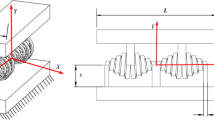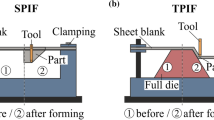Abstract
Compliant mechanisms are often used in combination with piezoelectric drivers in the design of high-precision linear stages. Numerous hinge designs have been developed due to varying requirements for stiffness and flexibility in different areas of the compliant mechanism frame. Their geometry was traditionally limited mostly to 2D shapes due to limitations of typically used manufacturing processes: electrical discharge machining and stamping. Novel additive manufacturing technologies could allow more complex shapes that could result in better performance. The objective of this paper was to minimize internal losses of the stage caused by unwanted material deformation to maximize efficiency and therefore, the displacement of the linear stage. For this purpose, finite element method simulation was used for the preliminary improvement of geometry, which was afterward confirmed with experimental results. The design of a compliant mechanism with perforated hinges achieved promising results in terms of efficiency improvement.
Similar content being viewed by others
References
Y. Du, T. Li and G. Gao, Dynamic analysis of a flexure-based compliant stage, Journal of Mechanical Science and Technology, 32 (2018) 5223–5231.
J. Hricko and Š. Havlik, Compliant mechanisms for motion/force amplifiers for robotics, Advances in Intelligence Systems and Computing, 980 (2020) 26–33.
S. Linß, S. Henning and L. Zentner, Chapter modeling and design of flexure hinge-based compliant mechanisms, Kinematics — Analysis and Applications, Intech Open (2019).
J. M. Paros, How to design flexure hinges, Machine Design (1965).
L. L. Howell, Kinematic synthesis of compliant mechanisms, 21st Century Kinematics — The 2012 NSF Workshop, J. M. McCarthy (Ed.), Springer (2019).
C. Culmone, P. W. J. Henselmans, R. I. B. van Starkenburg and P. Breedveld, Exploring non-assembly 3D printing for novel compliant surgical devices, PLoS ONE, 15(5) (2020) e0232952.
J. P. Sharkey, D. C. W. Foo, A. Kabla, J. J. Baumgerg and R. W. Bowman, A one-piece 3D printed flexure translation stage for open-source microscopy, Review of Scientific Instruments, 87(2) (2016) 025104.
P. Płatek, K. Rajkowski, K. Cieplak, M. Sarzynski, J. Malachowski, R. Woźniak and J. Janiszewski, Deformation process of 3D printed structures made from flexible material with different values of relative density, Polymers, 12(9) (2020) 9.
J. D. Kechagias, D. Chaidas, N. Vidakis, K. Salonitis and N. M. Vaxevanidis, Key parameters controlling surface quality and dimensional accuracy: a critical review of FFF process, Materials and Manufacturing Processes, 37(9) (2022) 963–984.
V. Chandran, J. Kalman, K. Fayazbakhsh and H. Bougherara, A comparative study of the tensile properties of compression molded and 3D printed PLA specimens in dry and water saturated conditions, Journal of Mechanical Science and Technology, 35 (2021) 1977–1985.
Author information
Authors and Affiliations
Corresponding author
Additional information
Marko Horvatek is a Ph.D. student at the Faculty of Mechanical Engineering and Naval Architecture, University of Zagreb. His research interests include micro and nano metrology, optical measurement devices, and additive manufacturing.
Rights and permissions
About this article
Cite this article
Horvatek, M. Improved linear stage hinge design suitable for additive manufacturing. J Mech Sci Technol 37, 1139–1144 (2023). https://doi.org/10.1007/s12206-022-2111-5
Received:
Revised:
Accepted:
Published:
Issue Date:
DOI: https://doi.org/10.1007/s12206-022-2111-5




